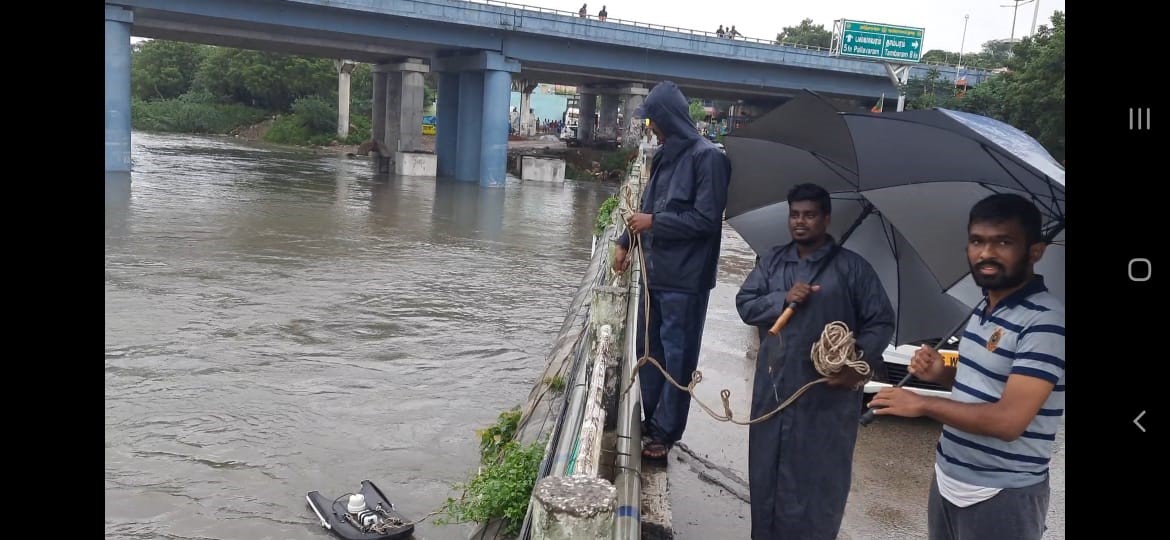IIT Madras Researchers braved Cyclone Nivar to collect real-time data on Adyar Rivers’ Discharge
Chennai: Indian Institute of Technology Madras Researchers and Students undertook important data collection exercise amidst the heavy rains and intense winds during Cyclone Nivar that could play a crucial role to prevent future floods in Chennai.
A team of faculty and students led by Prof. Balaji Narasimhan, Department of Civil Engineering, IIT Madras, measured river discharges at several critical places across the Adyar River to collect data in real-time during the Cyclone. Equipped with Acoustic Current Profiler, two teams of students and faculty measured river currents and flow depths across the width of the river to get the integrated flow rate of the river.
During the floods of 2015, such critical ground truth data and a reservoir inflow forecasting system through numerical models could have helped mitigate the impact. The catchments of Somangalam, Manimangalam, Adhanur and Guduvanchery in Chennai with a large network of tanks received a record amount of rainfall during the monsoon of December 2015.
Explaining the significance of this project, Mr. K. Phanindra Reddy IAS, Commissioner, Revenue Administration, Disaster Management and Mitigation, Government of Tamil Nadu, said, “The data collected during this field campaign by IIT Madras in close coordination with Tamil Nadu State Disaster Management Authority (TNSDMA) would be very useful to operationalize the Real Time Flood Forecasting (RTFF) and Spatial Decision Support System (SDSS) being coordinated by TNUIFLS under World Bank assisted Tamil Nadu Sustainable Urban Development Project (TNSUDP).”
Elaborating on the technical aspects of this project, Prof. Balaji Narasimhan said, “As part of a robust flood management, rating curves at critical sections of the rivers are especially important to understand the volumetric flow rate (in m3/s or ft3/s) for different flow depths (in m or ft). Once a rating curve is developed, an integrated network of water level sensors could be used to monitor the river discharges remotely and automatically at these critical river stretches.”
Some preliminary model runs showed that catchments of Somangalam, Manimangalam, Adhanur and Guduvanchery alone could have contributed to up to 70 per cent to 80 per cent of flood flows realised in Adyar River. Unlike the Chembarambakkam reservoir with flood gates to regulate the water level, the control measures available in the tanks in this part of the catchment was almost nil in 2015. Realising this lacuna, the State Public Works Department (PWD) has begun installing sluice gates in many of the small tanks to regulate the water levels prior to the incoming floods.
This data collection project arose after megafloods that hit Chennai during December 2015. IIT Madras along with IIT Bombay, Anna University and the National Centre for Coastal Research (NCCR), developed a pilot flood forecasting system with the funding support from the Principal Scientific Advisor, Government of India.
Through this funding support, a network consisting of 15 automatic weather stations, rain gauges and 6 water level recorders were also established in 2017. However, since 2017 all the subsequent years were all below normal monsoon years and hence sufficient ground truth data in terms of river discharge rate at critical sections could not be collected to validate the models developed as part of the pilot flood forecasting system.
Highlighting the outcomes from this project, Prof. Balaji Narasimhan, Department of Civil Engineering, IIT Madras, said, “This is an important exercise in calibrating and validating the developed flood forecasting models, so that based on forecasted rainfall by the India Meteorological Department (IMD) at different lead times (from 3 hrs to 72 hrs and even longer) could be used to forecast the river stage and discharges. The ground truth collected during this field campaign during Cyclone Nivar showed that certain parts of Adyar river contributed to up to almost 70 per cent of flow realised in Adyar river at Anakaputhur with the rest contributed by the Chembarambakkam releases.”
Although Chennai did not encounter large scale flooding during Cyclone Nivar, certain localities in the city experienced some flooding and waterlogging. The data collected during the field campaign, which continued till 11th December 2020, could give insights into the hydrological behaviour of this catchment and find remedies to mitigate future floods.
Further, Prof. Balaji Narasimhan said, “Even more critical is, the collected data would be incredibly useful to manage and moderate the reservoir releases from Chembarambakkam, giving sufficient lead time for officials from Tamil Nadu State Disaster Mitigation Authority (TNSDMA) to issue warning to the public in low-lying regions and coordinate flood mitigation and relief measures.”

